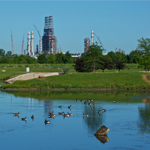Global refined product markets could incur a gasoline-supply surplus as early as 2017, according to the latest long-term oil product market forecast from U.K.-based consultancy Wood Mackenzie (www.woodmac.com). The research firm said such a surplus—together with insufficient fuel-oil and middle-distillate inventories—would impact refiners significantly by the end of the decade. This impending surplus could possibly accelerate certain refiner’s strategic initiatives to diversify into niche petrochemical markets.
In the short and medium-term refiners are beneficiaries of low crude-oil prices, unplanned refinery outages and the slower-than-expected startup of new facilities—which are collectively tightening the petroleum product markets. On top of that, refiners are struggling to meet gasoline demand growth of 420,000 bpd, while refined product export opportunities for U.S. refiners may increase to 3.9 million bpd in 2023 from the current 1.5 million bpd, according to the U.S. Energy Information Administration (EIA). However, WoodMackenzie analysts warn that oil demand growth will eventually slow in the long term because of increased efficiency and alternative-fuel sources. The firm expects margins to fall by 2019 to the minimum sustainable level for some refiners and identifies key market indicators that could see gasoline cracks bottom out at low levels last seen in 2013.
“Although gasoline cracks have been very strong this year, we could see a complete reversal in the market in just two years,” Jonathan Leitch, WoodMackenzie research director for oil-product markets research, observed in the report. “The outlook for 2016 remains similar and in many ways stable, but in 2020 we start to see a glut of gasoline supply developing—in excess of 30 million tonnes—which doesn’t go away for a decade.” The latest WoodMackenzie refined product analysis, which tracks 745 operational refineries globally, shows that gasoline yields are expected to increase 1% over the next 15 years. Even if no new refineries are built beyond 2020, there will still be a global gasoline glut for many years—the result of decelerating demand in the key North American market and slowing demand growth in Asia and Europe, which could offset most of the demand growth seen in the emerging Asian economies, Africa, Latin America and the Middle East, WoodMackenzie analysts noted.
Leitch further observed, “We expect to see particularly strong growth in LPG supply from NGLs in North America and the Middle East, and by 2019 margins could bottom out at minimum sustainable levels for Europe and Asia. We expect to see gasoline cracks come down and margins weakening again, taking us back to levels where we were last year and in 2013.” “Refiners could see an additional 5.5 million bpd in net refining capacity by 2020,” Leitch added. “This would put significant pressure on Europe and Asia for further capacity consolidation and the U.S. refining sector could also start to suffer, particularly in areas without access to export markets,” he concluded.








Leave a Reply
You must be logged in to post a comment.